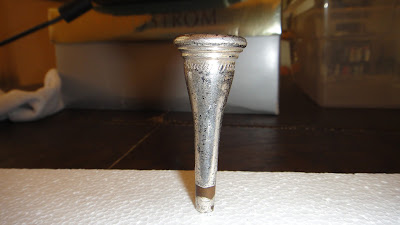Last summer I was sorting through a box of brass instrument mouthpieces, placing them on a table as I unpacked them. My mother happening to come by asked me, “How many mouthpieces do you need, anyway?”
Of course, there is no limit
to the number of mouthpieces I need, but what struck me about her question was
that although they may appear similar, there are worlds of differences between mouthpieces
that make ownership of many of them not an idle whim, but a vital necessity.
 |
| Unpacking these brass mouthpieces was like visiting old friends. |
I like to play old brass
instruments, especially the cornet and the alto horn, and each mouthpiece has
its own qualities and merits. The difference they can make in the playability
and sound of each instrument is almost unbelievable. This is in addition to
their different appearances and historical associations.
The mouthpieces they make
today can be very high quality, but may be very inappropriate to use with old
instruments. This is especially true for cornet mouthpieces, which used to be
conical in shape, and gave a more mellow sound. Today’s cornet mouthpieces are
more like miniature trumpet mouthpieces, featuring a cup-shaped interior, and give
even antique cornets a more brilliant, trumpet-like sound, which is at odds
with old cornet music, which, while capable of brilliance, revels in its moonbeams-and-roses,
Victorian atmosphere.
The late 19th and
early 20th century were the golden era of brass instruments, when
every town had its own brass band, and cornet and trombone soloists such as
Jules Levy, Herbert L. Clarke, and Arthur Pryor were all household names. Many
old mouthpieces feature the names of premium manufacturers, and were modeled
after the preferences of the famous brass soloists of years gone by.
When you obtain an old brass
instrument, you should gather as many historical mouthpieces as possible, and see
which ones fit the instrument, your anatomy (embouchure), and personal playing
style. Here are a few particular ones from my collection:
 |
| Here are two very early ivory mouthpieces made for bass instruments such as serpents and ophicleides. |
 |
| An example in the V&A of a serpent, an early bass instrument and predecessor of the ophicleide and tuba, and often played with ivory mouthpieces like the above. |
 |
| Arthur Pryor was a trombone player whose virtuosity was stunning, and whose playing was often captured on early records. He also wrote many brilliant trombone solos still played today. |
 |
| Frederick Neil Innes was another trombone soloist of the golden era, who likewise wrote solo compositions still popular with all brass players. |
 |
| A modern but fine quality French horn mouthpiece by Rudy Muck, which I found at a house sale just last summer. |
 |
| Three early trumpet mouthpieces, by Hill, anonymous, and Cousenon, the latter a fine French maker. |
 |
| More modern trumpet mouthpieces by Holton (always a great name), Vincent Bach (again), and H.N. White, a maker of professional quality instruments in Cleveland, Ohio. |
 |
| Finally, we get to the all-important category of cornet and bugle mouthpieces. Here are two very early examples. |
 |
| A spectacular find, “The only genuine Levy Model” made by Lyon and Healy. Jules Levy was the greatest cornetist of the late 19th century. |
How does one acquire so many
examples? When I was in college, I used to stop in at older-looking music
stores and ask if they had any old mouthpieces lying around. They usually came
up with a box of miscellaneous parts and junk from the back room from which I
could choose; some real treasures turned up this way.
If you play a wind or brass instrument, did you have a special mouthpiece that made all the difference when playing it? What about brass instruments in general—do you have a particular favorite? Although I most often play the alto horn, my real favorite is the old-fashioned cornet, especially when played by the likes of Jules Levy, Herbert Clarke, or Bohumir Kryl on early records.
You are supposed to blow
horns to usher in the New Year. I hope that this post will get everyone in the
mood, and that all my readers have a happy, healthy and prosperous 2018!
All mouthpieces and photos of same property of the
author.
Photos of Pryor, Levy and the Serpent via Wikipedia.Photo of Innes located here.











